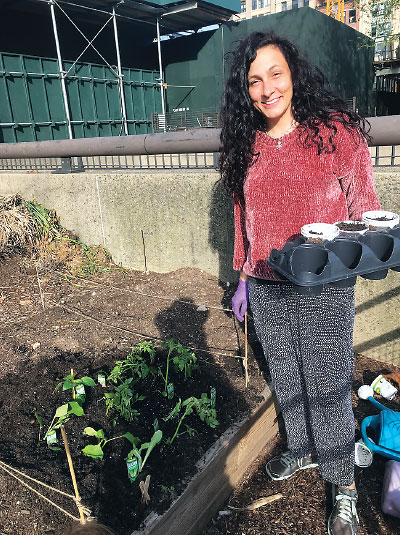Nature May Be Key to Strengthening Our Attention
Abstract
Though young, the field of studying the impact of green spaces on our cognition throughout the lifespan is growing. Many experts are hoping to see their research change the way communities are built. This is the second of a three-part series.
Since she was a child, Argelinda Baroni, M.D., has felt soothed when she spends time in natural and untamed places, as though she belongs to something bigger than herself. Sometimes, she looks across a wild landscape and points out to her children the way the sun cuts through the clouds or how the sky is reflected in the lake. “In those moments, I’m not a woman, I’m not a mother, I’m not a psychiatrist,” she said. “I am just a being in this time and space.”

Argelinda Baroni, M.D., works in the urban vegetable garden she shares with her neighbors. Baroni is especially interested in the impact that climate change has on mental health, as green spaces increasingly disappear.
Baroni is a clinical associate professor in the Department of Child and Adolescent Psychiatry at the NYU Grossman School of Medicine. She is far from alone in her affinity for the natural world. Many people intrinsically believe that if they step away from a built environment and enter a green space, such as a park or forest, they will feel better. Science backs up that belief. Research has shown associations between greater green space and a host of mental and other health benefits (Movement Emerges to Include Green Space as a Social Determinant of Mental Health). In recent decades, researchers have also started investigating how exposure to green space impacts cognitive functioning over time, asking the question: How does being in nature impact the way we think?
That question is becoming increasingly urgent. “As population distribution shifts progressively toward less-natural environments, each generation has a decrease of nature experience, especially during childhood,” Baroni wrote in a 2019 JAMA Network Open commentary, which accompanied a study that found that greater access to green areas among Chinese children was associated with lower odds of having attention-deficit/hyperactivity disorder symptoms.
“I think a lot of people, qualitatively, perceive that nature has an impact on them and that it makes them feel and think better,” Baroni said. “But we’re seeing more of an effort [in research] to better quantify what we’re feeling. Nature access is clearly a social determinant of health, and we are still learning about how exactly it affects us.”
Nature’s Impact on Different Aspects of Cognition
Like many who investigate green space and its impact on the mind, Marcia Pescador Jimenez, Ph.D., was inspired to pursue her research by her own experiences. “I’ve noticed that where I live throughout my life has had a big impact on my health and well-being,” she said. Pescador Jimenez is an assistant professor in the Epidemiology Department at Boston University.
Why Does Nature Help Us Think More Clearly?
There are various theories on why nature exposure improves cognitive function. Likely the most popular is attention restoration theory, which was developed by Rachel Kaplan, Ph.D., and Stephen Kaplan, Ph.D. It posits that exposure to natural environments may restore an individual’s ability to concentrate.
The theory suggests that a person’s direct attention is often taxed and depleted in overstimulating environments, which urban environments often are. Natural spaces, by contrast, engage what is referred to as soft fascination, which are aspects of the environment that capture attention effortlessly. To provide this restorative effect, however, the theory states that the natural environment must also allow the individual to feel immersed in the environment and provide an escape from habitual activities. Further, the individual must want to be in the natural space.
Gregory Bratman, Ph.D., noted that the posited effects from attention restoration theory can be measured through working memory or other cognitive tests. He and his colleagues conducted a study in which 60 individuals went for 50-minute walks in either a natural or urban environment. The participants completed a series of psychological assessments before and after the walks. Compared with those who went on the urban walk, the nature walk resulted in decreased anxiety, rumination, and increased working memory performance. The findings were published in 2015 in Landscape and Urban Planning.
Another theory is stress reduction theory, which posits that people experience restorative engagement of the parasympathetic nervous system when they are exposed to natural environments, especially those that provide sustenance or safety. It suggests that nature’s impact is due to humans’ evolutionary history, which has led us to harbor innate preferences for natural environments over urban ones.
Bratman is exploring his own theories related to nature’s impact on well-being that especially focus on emotion regulation, he said. He has done work investigating rumination, conducting a study with colleagues during which participants went for a 90-minute walk in urban and natural environments. Each participant underwent an arterial spin labeling scan to measure regional cerebral blood flow, which can detect effects associated with rumination. Those who walked in the natural environment -reported lower rumination levels after their walks and showed reduced neural activity associated with rumination. The findings were published in 2015 in Proceedings of the National Academy of Sciences.
Since that study, Bratman has been investigating other modes of emotional regulation as he explores how contact with nature might help decrease maladaptive strategies to regulate emotion and possibly increase adaptive emotion regulation strategies as well.
“We hope to have more work coming out related to this soon,” he said. “It’s a really exciting area.”
During the COVID-19 pandemic lockdowns, she was at home with her two small children and expected to continue working and focusing. “It was not going well,” she said. “I started going for long walks and some jogs outside. I live in a suburban place, and I was able to see a lot of trees and light coming through the leaves, and I noticed that when I came back, I felt way less stressed and more calm. I was able to work better and be more patient with my kids. I just felt happier.”
Pescador Jimenez’s research has backed up her personal experience. In a cohort study she and colleagues conducted among 13,594 women, increasing green space was associated with higher scores of overall cognition, thinking speed, and attention. The participants’ cognitive functioning was measured through the Cogstate Brief Battery, which consists of four tasks that measure psychomotor speed, attention, learning, and working memory. Pescador Jimenez and her colleagues did not identify an association between green space and learning or working memory, however. Their findings were published in JAMA Network Open in 2022.
An important question when thinking about the link between green space and cognition is the type of cognitive attributes being investigated, Pescador Jimenez pointed out. Studies have shown that green space is associated with improved cognition generally, but not with all metrics of cognition.
So, too, does the type of green space to which individuals are exposed likely impact cognition and well-being differently. Pescador Jimenez co-authored a systematic review and meta-analysis to investigate the association between green space and dementia. They found that living in a place with intermediate access to green space may protect against dementia, but that the same effect was not identified in areas with high amounts of green space. The authors hypothesized that this may be due to adverse effects such as greater social isolation and decreased interaction with neighbors for those who live in very rural areas. The study was published in Current Environmental Health Reports in 2022. The authors noted, however, that potential methodological limitations of the included studies may have affected the results.
How Can Research Inform Decision-Making?
Gregory Bratman, Ph.D., M.E.S.M., emphasized the need to understand more about how different types of contact with nature may improve cognitive function, especially when the goal is to use such research findings to impact policy. How do micro-restorative experiences, such as viewing a rooftop garden from afar, impact cognition, for example? Bratman is the director of the Environment and Well-Being Lab at the University of Washington’s College of the Environment.
“In many cases, certain aspects of cognitive function can benefit from those types of nature experiences, but not all,” Bratman said. “And it doesn’t always improve cognition for everyone. Nature experiences differ according to perspectives tied to personal relationships with nature, preferences, lived experiences, and other individual differences.”
Variabilities in measuring green space can prove challenging for researchers and hinder efforts to put research into practice. For example, because green space is linked with lower rates of dementia, increasing green space in neighborhoods where historically disadvantaged people live may help offset their increased risk for the illness, Pescador Jimenez said.
“[B]ut what type of greenness are we really talking about?” she said.
She is working to answer that question now. Using Google Street View images, she and her colleagues are developing green space metrics based on the shrubs, grass, flowers, and trees in an area. The metric will inform how much exposure to specific types of greenness impact health outcomes. Preliminary results suggest that the percentage of trees in an area may reduce residents’ dementia risk. “It’s ongoing work, but it’s something I’m very interested in because it will help us inform policies in very specific ways,” she said.
Uncovering What Is Behind Nature’s Impact on Cognition
Lilah Besser, Ph.D., M.S.P.H., research assistant professor at the University of Miami’s Comprehensive Center for Brain Health, said research into green space and dementia has especially exploded over the last few years. That may be driven by more funding to research dementia, but it could also have to do with the positive effects some studies have uncovered. “In my latest literature review, 74% of the papers found at least one positive or beneficial association between green space and brain health,” Besser said. The findings, on which Pescador Jimenez was a co-author, were published in the International Journal of Environmental Research and Public Health in April.

Like most researchers who investigate green space, Lilah Besser, Ph.D., M.S.P.H., was drawn to the area by her own experiences.
In a previous literature review published in BMJ Open in 2021, Besser found that greater green space was positively associated with various cognitive domains in 10 studies and with improved MRI outcomes (such as regional brain volumes, cortical thickness, and amygdala integrity) in three studies. Additionally, greater neighborhood greenness was associated with lower odds of cognitive impairment in some studies, but greater odds in other studies.
Yet understanding why studies are pinpointing these benefits is more difficult, Besser said. Some studies posit that it is greater access to physical activity, less air pollution, or less stress, while others come to different conclusions.
“It’s too early to say, but personally I think it’s likely more than one mechanism, and that’s what’s kind of exciting,” she said. “People go to green spaces and parks for different reasons. Some want to sit in them, and that lowers their blood pressure. Some want to do physical activities, which we know is a protective factor against a lot of negative outcomes. I think it’s a combination of all these things, and hopefully more research will lead us to more specific answers.” ■



